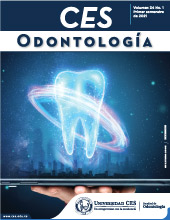Impact resistance of two conventional and two high impact acrylics for dentures
DOI:
https://doi.org/10.21615/cesodon.34.1.5Keywords:
Denture bases, Acrylic resins, Denture, Materials testing, AcrylicAbstract
Introduction and objective: acrylic resins are the ideal materials for the elaboration of dentures and removable prostheses, although the falls or blows
make them susceptible to fractures. Knowing the properties and limitations of acrylics in our environment, allows us to carry out treatments with the best materials. The objective of this study was to compare the impact resistance of two conventional and two high impact acrylics for prosthetic bases. Materials and methods: 40 bars were made in base-wax and processed in muffles according to specifications of four trademarks of acrylics (n=10), Lucitone199®, Masterdent acrylic resin®, Veracril alto impacto® and convencional®. The impact resistance was evaluated by the Charpy test (Machine ITC-XJU-22), with a pendulum mass of 0.237 Kg and an impact force of 1J. One-way ANOVA and tukey test were performed for statistical analysis was performed. Results: the impact resistance values were 16.5, 10.8, 9.3 and 5.9 KJ / m2 for Lucitone199®, Veracril alto impacto®, Veracril convencional® and
Masterdent acrylic resin®. Conclusions: with the limitations of this investigation, high impact acrylics can be considered as a more viable alternative for the elaboration of dentures compared to conventional acrylics, in order to reduce the risk of fractures due to accidents or sudden impact loads.
Downloads
References
Ministerio de Salud de Colombia. IV Estudio Nacional de Salud Bucal - Capitulo 3. 2013.
Alhareb AO, Akil HM, Ahmad ZA. Impact strength, fracture toughness and hardness improvement of PMMA denture base through addition of nitrile rubber/ceramic fillers. The Saudi Journal for Dental Research. 2017;8(1):26-34.
Ajaj-ALKordy NM, Alsaadi MH. Elastic modulus and flexural strength comparisons of high-impact and traditional denture base acrylic resins. Saudi Dent J. 2014;26(1):15-18.
Thompson H, Bourbonniere M. Traumatic injury in the older adultfrom head to toe. Crit Care Nurs Clin N Am. 2006;18:419-431.
Mansour MM, Wagner WC, Chu T-MG. Effect of mica reinforcement on the flexural strength and microhardness of polymethyl methacrylate denture resin. J Prosthodont. 2013;22(3):179-183.
Kanie T, Fujii K, Arikawa H, Inoue K. Flexural properties and impact strength of denture base polymer reinforced with woven glass fibers. Dent Mater. 2000;16(2):150-158.
Qasim SB, Kheraif AAA, Ramakrishaniah R. An Investigation into the Impact and Flexural Strength of Light Cure Denture Resin Reinforced with Carbon Nanotubes. 2012;5.
Hari Prasad A. Effect of glass fiber and silane treated glass fiber reinforcement on impact strength of maxillary complete denture. annals and essences of dentistry. 2011;3(4):7-12.
Zappini G, Kammann A, Wachter W. Comparison of fracture tests of denture base materials. The Journal of Prosthetic Dentistry. 2003;90(6):578-585.
Jagger DC, Jagger RG, Allen SM, Harrison A. An investigation into the transverse and impact strength of «high strength» denture base acrylic resins. J Oral Rehabil. 2002;29(3):263-267.
Ortega Y. Prueba de impacto: ensayo Charpy. Rev Mex Fís E. 2006;52(1):51-57.
International Organization for Standarization. Norma ISO 1567:1999. 1999.
Meng TR, Latta MA. Physical properties of four acrylic denture base resins. J Contemp Dent Pract. 2005;6(4):93-100.
Dikbas O, Unalan G& F. Comparative study of impact strength of six acrylic denture resins. Materials Research Innovations. 2010;14(3):231-233.
Gupta A, Tewari RK. Evaluation and comparison of transverse and impact strength of different high strength denture base resins. Indian Journal of Dental Research. 2016;27(1):61.
Narendra R, Reddy N, Reddy S, Sashi C, Chandra M, Balasubramanyam S. A comparative evaluation of impact strength of conventionally heat cured and high impact heat cured polymethyl methacrylate denture base resins: an in vitro study. J Contemp Dent Pract. 2013;14(6).
Oku JI. Impact properties of acrylic denture base resin. Part 1. A new method for determination of impact properties. Dent Mater J. 1988;7(2):166-173.
Downloads
Published
How to Cite
Issue
Section
License
Copyright (c) 2021 CES Odontología

This work is licensed under a Creative Commons Attribution-NonCommercial-ShareAlike 4.0 International License.
| Article metrics | |
|---|---|
| Abstract views | |
| Galley vies | |
| PDF Views | |
| HTML views | |
| Other views | |



